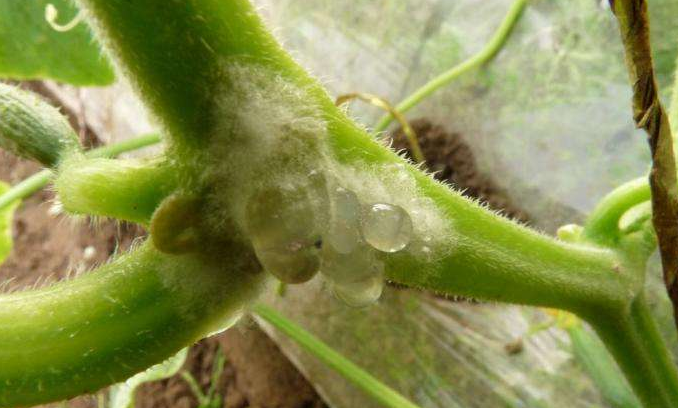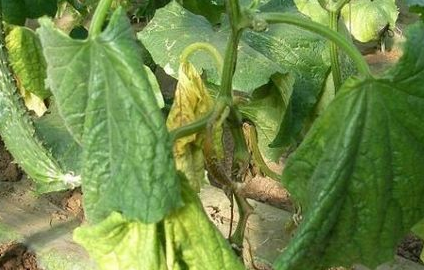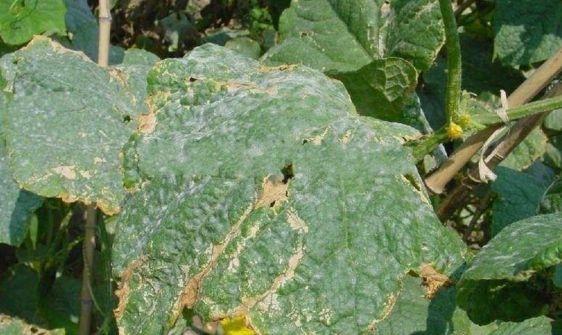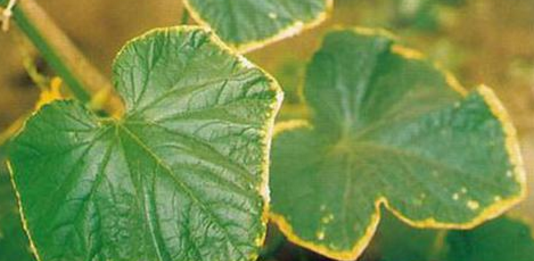Cucumber powdery mildew
Symptoms: Mainly harmful to the leaves. At the beginning, white small powder spots appeared on the leaves, gradually expanding into round white powdery spots, and later turned grayish white, and many small black spots were formed on the surface of the lesions in the later stage. The symptoms on the petiole and tender stem are similar to those in the leaves.

Prevention: Strengthen field management, pay attention to ventilation and light, and properly water the plants to prevent plant growth and premature aging. In the early stage of the disease, 50% Tsuibei dry suspension agent 3000 times solution, 60% Baitai water dispersion granule 1500 times solution, 25% Kairun emulsifiable concentrate 3000 times solution, etc., should be used before noon, spray once every 7 days, Continuous control 3 times, alternately select the agent.
Cucumber downy mildew
Symptoms: Mainly harmful to the leaves. It occurs mostly after flowering, and begins to develop from the lower part of the old leaves. At the beginning of the disease, water-stained and light green spots appear on the back of the leaves. After expansion, the veins are restricted by polygons. The color of the lesions changes to green and yellow, and finally turns brown. In the case of moisture, a purple black mold layer grows on the lesion on the back of the leaf.

Prevention: First, greenhouses and greenhouses should reduce humidity. Secondly, it is necessary to formulate fertilization and increase the application of boron fertilizer. In the early morning of the onset of the disease, the chemical control in the morning: 60% Baitai water dispersible granules 1500 times solution, 25% Kairun emulsifiable concentrate 3000 times solution, 50% Anke WP 1500 times solution, 68% Redolmer WP 600 times liquid, as well as chlorothalonil and mancozeb series products, can be used alternately.
Cucumber gray mold
Symptoms: mainly harmful to young melons, leaves and stems. The pathogens invade from the defeated female flowers, causing the petals to rot, and grow a gray-brown mold layer, and then spread to the young melons, so that the umbilical part is water-stained, the young melons quickly become soft, shrink, rot, and the surface is covered with ash. Brown mold layer. Burnt flowers and rotten melons fall on the stems and leaves, causing the onset of stems and leaves, forming large gray-brown large lesions on the leaves, and the edges are obvious; on the stems, several knots of decay, the melons are broken, and the plants die.

Control: greenhouses and greenhouses are treated with sorghum cultivation and drip irrigation. In the early stage of growth and after the onset, watering is properly controlled, and the wind is released at night, reducing humidity, reducing condensation on the roof and leaves, and spitting water at the edge of the leaves. Clean the dust on the shed and enhance the light. At the beginning of the disease, you can use 50% of the agricultural Lishui water dispersing agent 1000 times solution, 50% Kaiser water dispersion granules 1500 times solution, etc., spray once every 7 to 10 days, for 2 to 3 times in a row, pay attention to the alternating use of pesticides. . When the flower is spent, add 10 times of the nutrients to the liquid.
Cucumber sclerotinia
Symptoms: from the seedling stage to the adult stage, the disease can occur at a height of 5 to 30 cm from the ground. The umbilical part of the melon is formed with water-immersed lesions, soft rot, the surface is covered with cotton-like mycelium, and finally black bacteria are produced. nuclear. The stem was damaged and began to produce fading water-immersed lesions, gradually expanding into a light brown, diseased stem soft rot; growing white cotton-like mycelium, forming hard sclerotia in the stem epidermis and medullary cavity, and the plants withered. When the seedlings are onset, water-immersed lesions appear on the base of the young stem near the ground. The lesions are wound around the stem for a week, and the seedlings collapse.

Prevention and treatment: 60% Baitai dispersible granule 1000 times solution, 50% Kaiser water dispersible granule 1000 times solution, 50% Nongliin dry suspension agent 1000 times solution, 40% sclerotium net WP 800 Double liquid spray, spray once every 7 to 10 days, continuously spray 2 to 3 times, or use 50% of the nutrient dry suspension agent 100 times solution to spread the affected part.
Cucumber blight
Symptoms: Large lesions with near-circular or irregular shape are produced after the leaves are damaged. Some lesions develop inward from the leaf margins in a "V" shape or semi-circular shape, light brown, and the lesions are easily broken and often cracked. After drying, it is yellowish brown to reddish brown, and the spots are densely colored with black dots. When the petiole, melon vine or stem base is damaged, the lesion is oil-immersed, round to fusiform, yellow-brown, and sometimes overflows with amber resin-like gel. When the disease is serious, the stem section becomes black, rot, and broken. Gummy stem blight and more towards internal development stems from the surface, the same brown vascular bundles.

Control: spray 70% of the product dry suspension agent 800 times solution, 50% Tsuibei dry suspension agent 3000 times solution, 60% Baitai water dispersion granules 1500 times solution, 25% Kairun emulsifiable concentrate 3000 times solution, 75% Chlorothalonil WP 600 times solution, 50% thiophanate-methyl WP 500 times solution, greenhouse greenhouse can use 30% chlorothalonil smoke agent per 667 square meters 250 grams of smoke, 7 to 10 days of application 1, continuous control 2 to 3 times.
Cucumber physiological diseases
Cucumber fungicide injury
The main symptoms: distinct spots or dry spots appear on the leaves, which is more consistent over time symptoms occur often flood the area appears, and no tendency to spread, this happens more pesticide injury.

Cause: The time of administration is not appropriate. For example, when the drug is used at a high temperature, the water in the drug solution evaporates rapidly, and the concentration of the drug solution is doubled to cause the occurrence of the drug damage; then the concentration of the drug is too large, or the drug solution is excessively sprayed; some pesticides can also cause injury to improper compounding, such as mixing an acidic agent and alkaline agent spray, not only reduces the efficacy injury may occur; Further, when using the injury appears not timely fumigant leaked.
Control methods: scientific and rational use of drugs, strictly in accordance with the use of pesticides and the use of dosage; try to avoid the use of cucumber when the resistance is poor, do not apply at high temperature, hot sun noon; once the wrong pesticide is used, spray water immediately, If Chinese medicine is found to be harmful, it is necessary to timely irrigate the water, increase the application of tree-producing fertilizer, promote the development of cucumber roots, and enhance its recovery ability. At the same time, it combines spraying and harvesting No.1, Yundaquanshu, Tianda 2116 and other mitigation remedies.
Cucumber leaves white net
Main symptoms: The white and smear of the middle and upper leaves of the plants in the cucumber production of the protected area showed more symptoms from the tip of the leaf and developed along the edge of the leaf. In severe cases, it also develops into the interior of the blade. The leaves are dry in the late stage.

Causes of the disease: This is due to magnesium deficiency caused by excess potassium, because when the concentration of potassium in the soil is too high, it will affect the absorption of magnesium by cucumber. According to relevant tests, when potassium and magnesium are present in the soil. When the ratio reaches 8:1, it will cause magnesium deficiency, which leads to the emergence of white net edge blades.
Control methods: First of all, balanced fertilization ~ base fertilizer should be fully decomposed organic fertilizer, nitrogen, phosphorus, potassium and other fertilizers should be applied reasonably, especially the phosphate fertilizer should not be too small. Then pay attention to the application of magnesium fertilizer ~ sand and sandy loam soil will generally be deficient in magnesium, so the application of magnesium fertilizer should be strengthened, calcium magnesium phosphate fertilizer, ammonium magnesium phosphate fertilizer, etc.; and 2% magnesium sulfate sprayed in time Aqueous solution.
Cucumber yellow leaf
The main symptoms: This situation usually occurs after a cloudy day, the yellowing phenomenon is mainly in the middle and upper leaves, and it is from the cucumber picking period, the leaf back is water-immersed in the early morning, as the temperature rises to noon Can disappear. Generally, this yellowish leaf appears in the cloudy day for about 5 days, and finally the whole whole leaf is yellowed, and the veins can still remain green. When the plant is pulled out, the capillary root system can be found to be significantly reduced.

Causes of the disease: This situation often occurs in varieties with weak growth, and more alkaline soil sheds occur. In addition, the fertilizer in the early stage of growth of the fertilizer is too large, the amount of roots is small, and the leaves are thin. If the temperature is low or cloudy, it will easily lead to yellowing of the leaves.
Control method: properly control water and fertilizer in the early stage of cucumber growth, especially control the use of nitrogen fertilizer, promote root development and improve plant resistance; in addition, various measures are taken to increase greenhouse temperature and greenhouse light intensity.
Cucumber leaf
Main symptoms: It is easy to occur under low temperature and low light. Cucumber bubble leaves mostly occur in the middle and lower leaves of the plant. Many uneven bubbles appear on the front of the leaves, and the later part is chlorotic, and finally turns yellow. Or brown.

Cause: This situation has a great relationship with the growth environment of cucumber. The temperature during the planting period is too low, the plant growth is always in a slow growth state, or the continuous snowy weather is encountered in the middle of the cucumber growth period, the light intensity is seriously insufficient, and suddenly the weather If the temperature is sharp, the temperature of the shed will increase rapidly, or the sunny water will be followed by watering, which may cause this kind of bad condition.
Control method: In addition to selecting varieties with high resistance to low temperature and low light, and cultivating strong seedlings, we must also pay attention to strengthening temperature and humidity management, especially the minimum temperature in the winter simmered cucumber shed can not be lower than 15 degrees; In order to increase the luminous rate of the greenhouse, it is necessary to add a reflective curtain and a fill light to enhance the illumination. In addition, it can also be sprayed with Harvesting No. 1 and Yunda 120 to enhance the comprehensive resistance of cucumber.
A Foot Spa Machine with heat is a device used to provide a relaxing and therapeutic foot massage. It usually has a basin filled with warm water and has various massage settings such as vibration, bubbles, and rollers. The heat function helps soothe tired and aching feet, while the massage setting provides a deep-tissue massage that helps improve circulation, reduce tension, and relieve pain. Some foot spas also come with removable attachments, such as pumice stones and brushes, for extra exfoliation and cleansing. Overall, a foot spa machine with heat is a great tool for anyone looking to pamper their feet and promote overall relaxation and wellness.
Foot Spa Machine With Heat,Bubble Foot Bath Massager,Foot Massage Machine,Pedicure Foot Spa Machine
Huaian Mimir Electric Appliance Co., LTD , https://www.mmfootspa.com